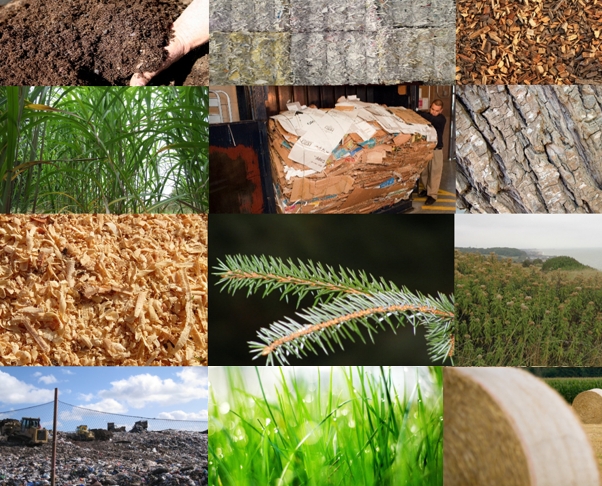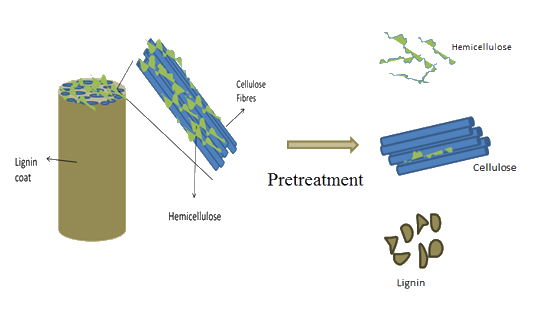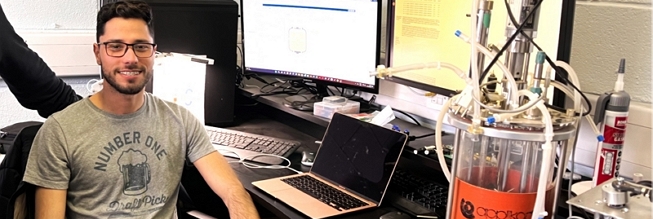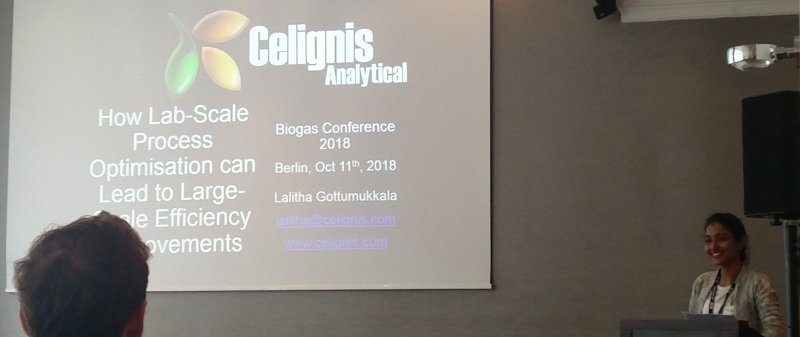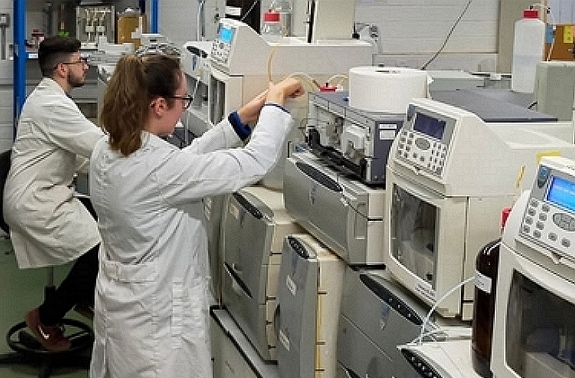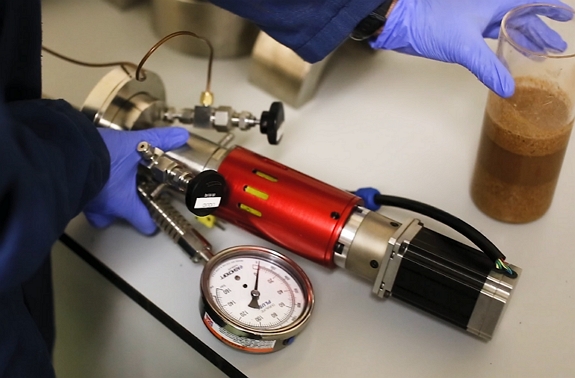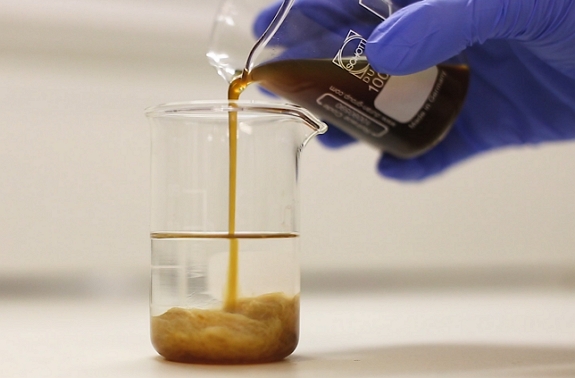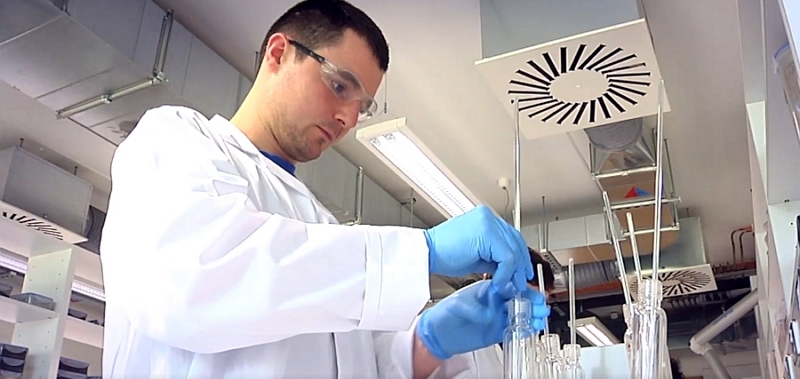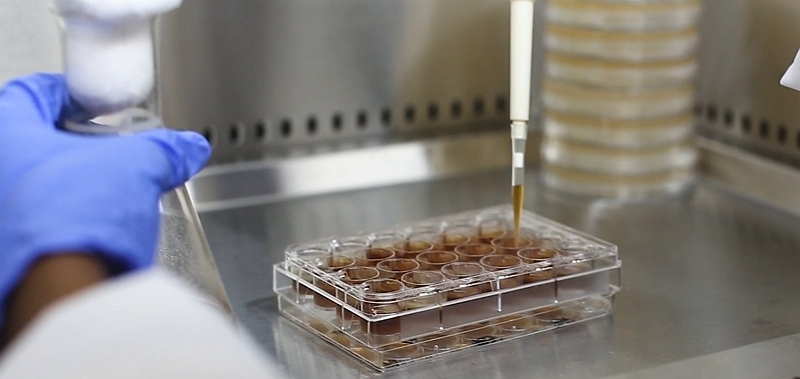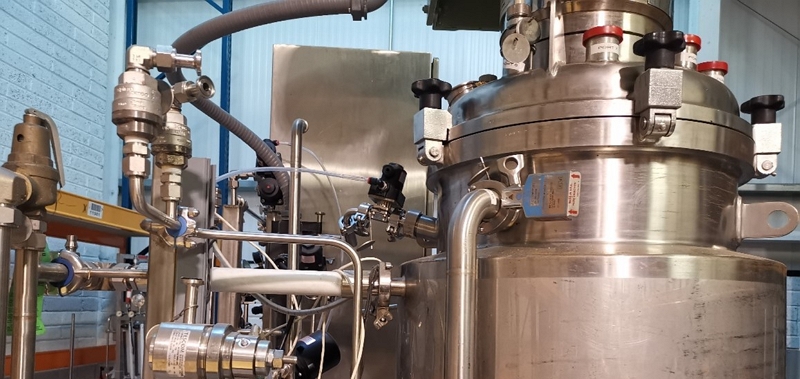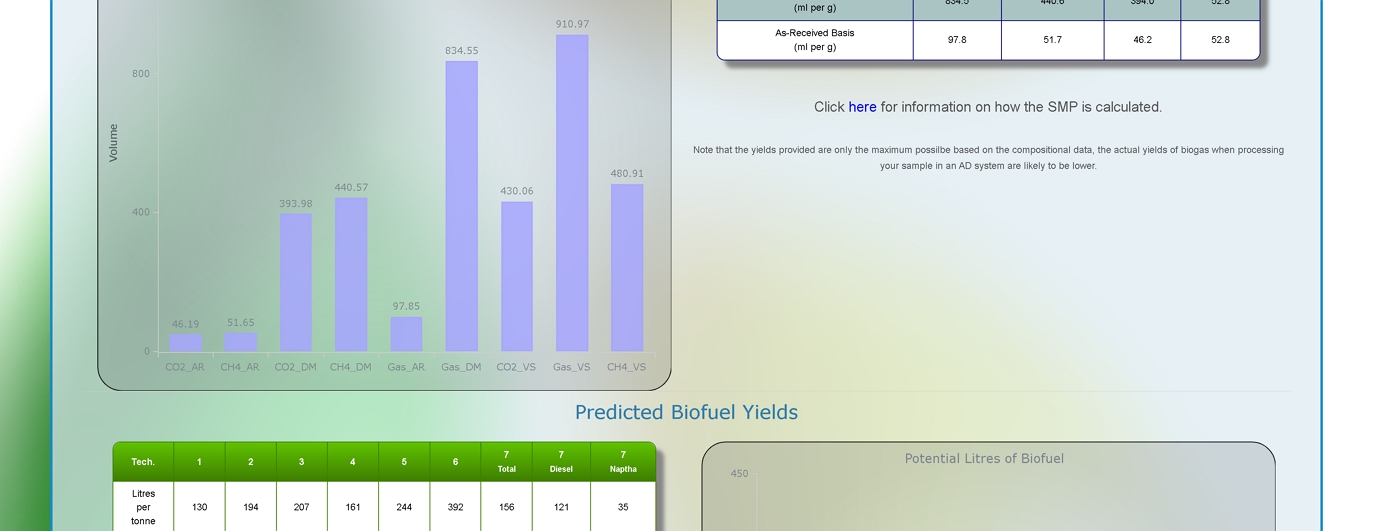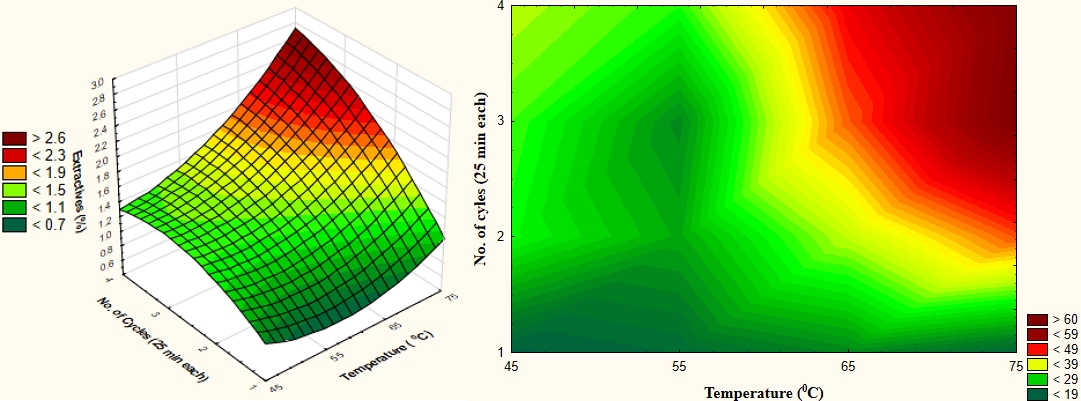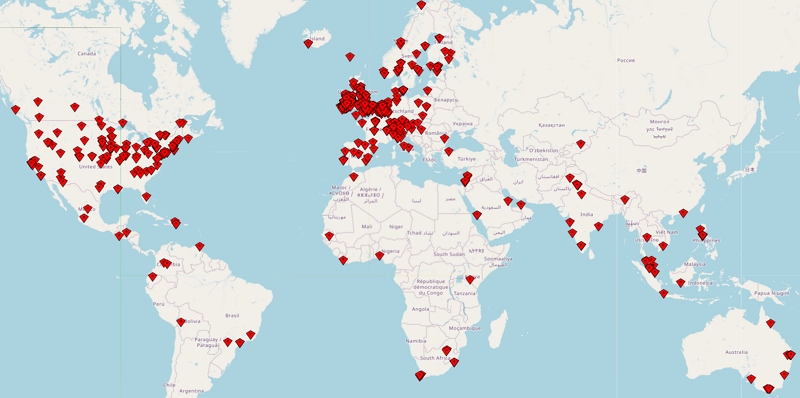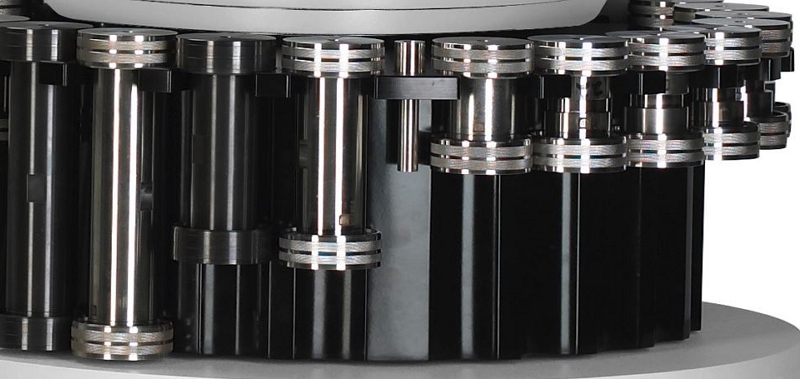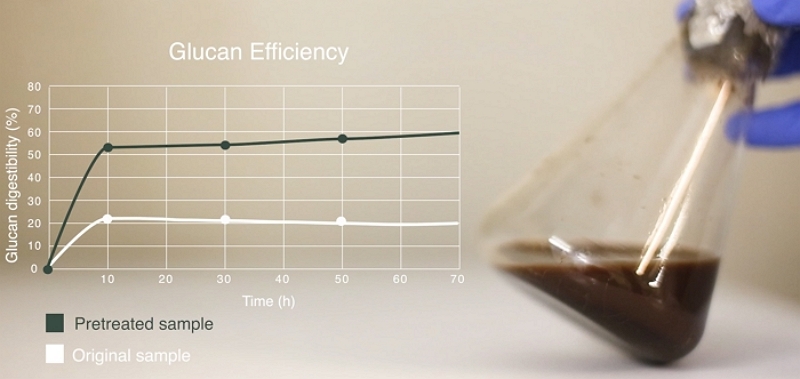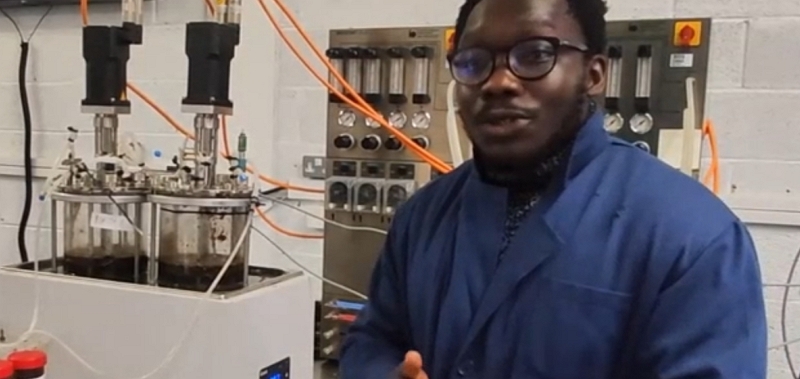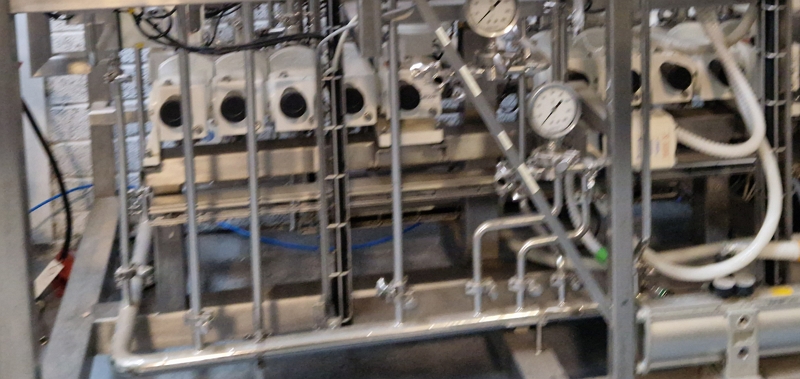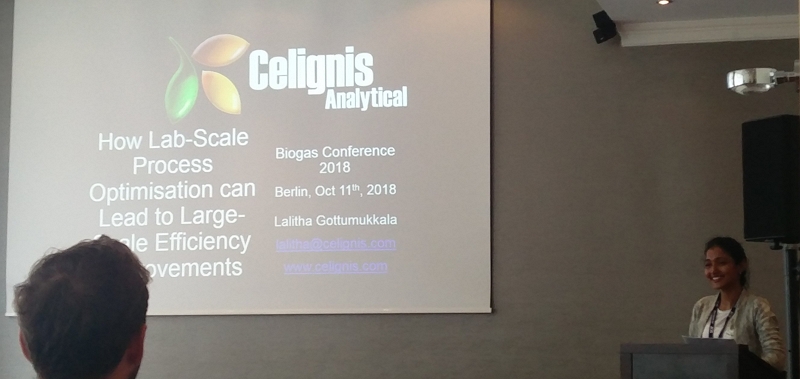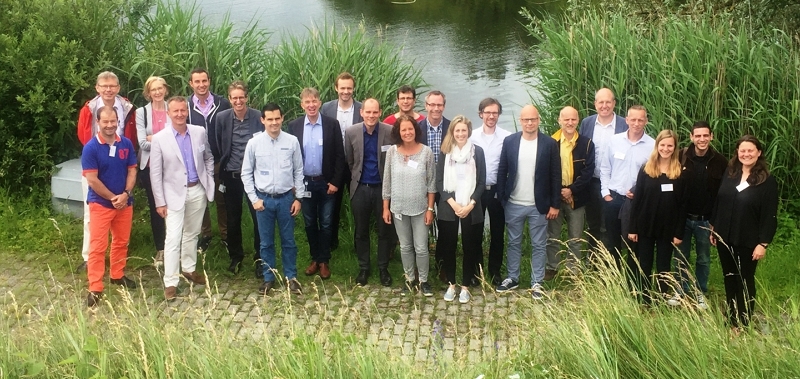Biomass Pretreatment Processes
Background
Lignocellulosic Biomass
Lignocellulosic biomass is defined as a plant, or plant-derived, material that is mostly composed of cellulose, hemicellulose, and lignin. Lignocellulosic feedstocks are highly abundant, covering many biomass types including grasses, wood, energy crops (e.g. Miscanthus and coppices), agricultural residues (e.g. straws and corn stover), and municipal wastes.Lignocellulosic feedstocks are highly abundant and can often be sourced sustainably, at low cost, without leading to land-use conflicts. As a result, there is currently great interest in obtaining chemicals, fuels, and biomaterials from such biomass.
However, the hydrolysis of lignocellulosic polysaccharides is not easy and is influenced by the complex inter-associations between hemicellulose and cellulose and between these polysaccharides and lignin in the lignocellulosic matrix. In particular, the crystalline nature of much cellulose and the existence of a physical barrier of lignin surrounding the cellulose fibres are said to be major contributors to the recalcitrance of cellulose.
The mechanism of hydrolysis is further complicated by the fact that different process intensities are required for the hydrolysis of cellulose versus hemicellulose. The more intense conditions required for cellulose hydrolysis may degrade the sugars hydrolysed from hemicellulose (to products such as furfural and formic acid).
For this reason, most hydrolysis technologies employ pre-treatment processes that aim to break apart the matrix (and in particular the associations between lignin and cellulose), reduce cellulose crystallinty, and hydrolyse hemicelluloses, hence separating the hydrolysate from cellulose which can then undergo more severe/targeted treatment.
Get more info...Biomass Hydrolysis
Need for Pretreatment
For this reason, most hydrolysis technologies employ pre-treatment processes that aim to break apart the matrix (and in particular the associations between lignin and cellulose), reduce cellulose crystallinty, and hydrolyse hemicelluloses, hence separating the hydrolysate from cellulose which can then undergo more severe/targeted treatment.Feedstock Chemistry
The chemical composition of lignocellulosic feedstocks varies greatly. This variability if seen not only in the relative proportions of the different polymers of lignocellulose (cellulose, hemicellulose, lignin) but also in the compositions of each of these polymers.The particular chemistry of the feedstock is a crucial factor when deciding on an optimal pretreatment, since some types of biomass (due to their chemistry) are unsuitable for certain pretreatment technologies. For instance, steam explosion is much less effective as a pretreatment on softwoods compared with hardwoods due to the fact that softwood hemicelluloses do not contain acetyl groups (which aids the mechanisms of steam explosion pretreatment). Similarly, a feedstock with a very high lignin content may be more suited to organosolv pretreatments that can separate the lignin from the cellulose, allowing the feedstock to be more accessible to cellulase enzymes.
The content and composition of extractives is also an important consideration when designing a pre-treatment process since these can complicate downstream valorisation stages.
Lignocellulose Fractionation
Some pretreatment processes (e.g. steam explosion) focus primarily on a disruption of the lignocellulose matrix to allow for it to be more readily hydrolysed in downstream processes. However, other technologies (e.g. when using acids, alkalis, solvents, or hydrothermal pretreatment) involve the production of two (or more) process streams with the primary lignocellulose polymers (cellulose, hemicellulose, lignin) displaying a preference for one of these streams.For example, an organosolv approach employing acetone as the solvent (as was the case in our CBE project UNRAVEL) would result in the hemicellulose and lignin in the liquid phase with the solid phase mostly composed of cellulose.
Hence, if your target for biomass valorisation is different downstream processes for each polymer then certain types of pretreatments that allows for such fractionation of biomass chemistry should be preferred.
Downstream Technologies
There are different ways in which the output streams (solid and liquid) of the pretreatment process can be valorised. For example, the hemicellulose sugars that become separated into the liquid phase in a number of pretreatment processes (e.g. acid pretreatments and hydrothermal pretreatments) can be biologically-processed (e.g. fermented to ethanol) or chemically/catalytically processed (e.g. catalytic production of xylitol from xylose).Each type of downstream valorisation process will have its own preferred conditions and requirements for the composition of the stream being processed. For example, many organisms used for fermentations may have their activities inhibited by the presence of degradation products of the sugars (e.g. furfural is the degradation product of xylose and arabinose). This would lead to a preference for a pretreatment that minimises the formation of inhibitors (for example hydrothermal pretreatment may be favoured over an acid pretreatment in this case). Conversely, if you are using a downstream technology that is not affected by these inhibitors then other aspects of the pretreatment become more important (for example, the process with the lower CAPEX/OPEX or the process which provides the highest yields of monomeric sugars).
Commercial & Environmental Viability
For a bioprocess to be commercially-viable it is necessary for the revenues associated with it to exceed the operating costs and that these operating margins cover the CAPEX in a reasonable timeframe.Some pretreatments can have significantly higher CAPEX and/or OPEX than others. However this does not mean that they are not commercially viable since they may provide more valuable products. An example would be organosolv technologies which typically have higher OPEX costs (due to chemicals usage and the energy costs of product/solvent recovery) and CAPEX costs. However, organosolvs can produce a high-quality lignin with signficant revenue-generation potential. For this potential to be realised pretreatment optimisation should focus on the use of a feedstock, and the development of a process, that will achieve the product requirements for entering these higher-value markets.
Similarly, bioprocesses targeting products to replace fossil-derived products should be demonstrably more sustainable. Hence, the pretreatment and downstream steps should be optimised so that the greenhouse gas emmissions, and environmental impacts of the whole process, represent a signficant improvement on the status-quo.
At Celignis we are experts in the technoeconomic analysis (TEA) of bioprocesses and consider this, as well as the environmental impacts, at all stages of process development.
Types of Biomass Pretreament
Get more info...Mechanical Pretreatment
Get more info...Steam Pretreatment
Get more info...Hydrothermal Pretreatment
Get more info...Acid Pretreatment
Get more info...Acid Pretreatment
Get more info...Organosolv Pretreatment
Get more info...Other Pretreatments
How Celignis Develops Biomass Pretreatments for Our Clients
1. Understanding Your Requirements
Prior to undertaking bioprocess projects we learn from our clients what their targets are from the process as well as whether there are any restrictions or requirements that may need to form the boundaries of the work that we undertake. These help to guide us to then prepare a potential bioprocess development project.
For example, in the context of pretreatment, the primary target of one client may be to achieve the greatest possible glucose yields from cellulose, with the valorisation of the other main components of biomass (e.g. lignin and hemicellulose) being of much lesser importance. In contrast, another client may be particularly focused on the production of oligomers from hemicellulose, with the efficient hydrolysis of cellulose being lower down in their list of priorities. Such differing targets are likely to lead to either different pretreatment technologies being used in each case and/or in the selection of different process parameter ranges for the experiments to be undertaken.
Similarly, a requirement from a client for no chemicals to be used would narrow-down the range of options that we could consider for the pretreatment process.
2. Detailed Feedstock Analysis
A thorough understanding of the chemistry of a feedstock is a crucial component in designing an effective pretreatment process. Detailed compositional analysis is also necessary in order to accurately determine process yields and efficiencies.
We recommend that each feedstock that is to be investigated for pretreatment be analysed with one of our in-depth lignocellulose analysis packages (P10 or, ideally, P19). We advise that these analyses are undertaken prior to the start of the bioprocess project as the resulting data will allow us to consider the appropriate pretreatment technologies and process conditions for any particular feedstock.
Hence, based on the analytical results and the client's requirements, the Celignis Bioprocess team will then meet to discuss and prepare a project proposal for biomass pretreatment development and optimisation. After this proposal is reviewed by the client, and revised if needed, we are then ready to start work on developing the pretreatment process.
3. Lab-Scale Pretreatments
Our projects usually involve undertaking a number of pretreatment experiments, covering a variety of process conditions. We follow a scientifically-based Design of Experiments (DoE) protocol where the criteria and boundaries for this DoE are formulated in close collaboration with our clients, considering the chemistry of the feedstock(s) and our understandings of the mechanisms of biomass pretreatment.
We usually recommend that these initial optimisation experiments are undertaken at the lab-scale (around TRL3) in order to reduce costs and the length of the project. For each experiment we analyse the solid and liquid outputs of the pretreatment process, leading to a detailed data-set where effects of process conditions on the yield and composition of the various streams can be explored and mapped.
We can also undertake a second iteration of lab-scale experiments in order to fine-tune the conditions based on the knowledge gained in the initial experiments.
4. Downstream Valorisation Experiments
The analytical results from our lab-scale experiments will provide us with valuable data on the composition of the various output streams (e.g. solid and liquid) from the pretreatment process. However, to fully evaluate these streams for their suitability for the planned applications (for example, ethanol from the cellulosic fraction) we advise that their downstream processing is tested.
We can undertake a wide variety of tests here, based on our client's requirements and the targeted end products. The results from these experiments allow for a more thorough evaluation of the pretreatment process and for the conditions to be optimised according to the final product requirements, rather than just according to the chemical composition of the pretreatment's output streams.
We advise that these initial downstream valorisation experiments are also undertaken at the lab-scale, using the outputs of Stage 3. This will enable us to gather more data, at lower costs, allowing for the pretreatment process to be optimised most effectively.
5. Validation at Higher TRLs
Once we have concluded our optimisation of the pretreatment process conditions at the lab-scale we can then test those conditions at higher technology readiness levels (TRLs). The scales at which we can operate are dependent on the type of pretreatment technology employed, but can reach up to 100 litres.
We have all of the necessary downstream equipment to efficiently handle the solid and liquid streams arising from these scaled-up activities and we can also undertake scaled-up processing of these different fractions from the preatment, for example high-TRL enzymatic hydrolysis runs for the solids and fermentation runs for the liquid stream.
If we find that there are differences between the yield and compositions of the different post-pretreatment streams, compared with our lab-scale experiments, then we can explore the potential reasons for these and work on final tweaks to optimise the bioprocess for higher TRLs.
6. Technoeconomic Analysis (TEA)
The Celignis team, including Oscar our chief TEA expert, can undertake a detailed technoeconomic analysis of the developed process. We apply accurate and realistic costing models to determine the CAPEX and OPEX of simulated and pilot scale processes which are then used to determine key economic indicators such as IRR, NPV and payback periods.
Within these TEAs we can consider the pretreatment as a discrete independent module or we can evaluate the biomass valorisation process as a whole, evaluating the impact of the pretreatment on the whole biorefinery concept. We also undertake sensitivity analyses to assess the effect of variable costs and revenues on the commercial viability of the pre-treatment process.
Our preferred approach is to include TEA studies at each stage of the development of the pretreatment bioprocess, so that the process can be optimised in a commercially-relevant way, followed by a more detailed TEA after the process has been optimised and tested at higher TRL levels.
Click here to read more about the technoeconomic analysis (TEA) services offered by Celignis.
Bioprocess Pretreatment Projects - Case Studies
Pretreatment of Palm Residues
Celignis undertook a bioprocess development project for a client, based in the Middle East, that was targeting the production of ethanol from the residues of local palm trees. This was a lab-scale vertically-integrated project covering pretreatment, hydrolysis, and fermentation.The client initially had a certain type of pretreatment technology in mind and requested that we undertake a series of experiments to assess it. However, based on our initial compositional analysis of the feedstocks, we had reservations that the chosen pretreatment would be suitable for such biomass. We discussed this with the client and it was agreed that three different types of pretreatments were tested, with each pretreatment type being undertaken a number of times in order to allow for an initial evaluation on the effects of varying the process parameters on the yield and compositions of the output streams.
The results from these initial pretreatment experiments confirmed Celignis's reservations regarding the originally-chosen pretreatment and resulted in the pretreatment technology that we recommended, based on the feedstock compositional data, being selected for further study.
There then followed a more extensive series of lab-scale experiments focused on optimising the pretreatment conditions so that the yields and commercial viability of the process as a whole could be improved.
Pre-Pretreatment Extraction
Extractives, if present in signficant quantities in the feedstock, can present a challenge to certain pretreatment technologies. For example, in organosolv pretreatments the extractives typically end-up in the liquid output stream of the process, along with lignin and hemicellulose sugars. At that point it can be hard to separate these extractives from the lignin meaning that the final lignin product may have a lower purity and, potentially, a lower market value.In the CBE project UNRAVEL, completed in 2022 and focused on the development of biomass pretreatment, one of Celignis's main roles was to optimise an extraction process focused on removing the extractives prior to the pretreatment stage. Complete removal of all extractives can be a costly process in terms of chemical and energy requirements. Hence, the primary objective of the work was to develop an optimised pre-extraction process that produced a substrate suitable for the pretreatment process while minimising the cost and complexity of the process.
Celignis undertook a detailed and extensive DoE, considering a wide variety of parameters including feedstock, particle size, temperature, residence-time, solvent(s) used, and extraction cycles. The final output of the work was a protocol, optimised for each feedstock, for extractives removal prior to the main pretreatment process.
Prodution of Oligomers from Hemicellulose
Celignis undertook a bioprocess development project for a client where the focus was on the optimisation of process conditions to allow for increased yields of oligomeric sugars from the hemicellulose of an agricultural residue feedstock.The approach was challenging as the target was efficient hydrolysis of hemicellulose to oligomers without those oligomers then being further hydrolysed to monomeric sugars.
The Celignis Bioprocess team spent some time working with our client in order to understand their targets and their restrictions in terms of chemical and energy usage. We then formulated a DoE to explore the effects of different types of pretreatments and process conditions on the yield of oligomers and on the oligomer/monomer ratios.
The results of our experiments allowed for a much more focused narrowing-down of the process conditions that would allow oligomers to be produced in high yields and at enhanced purities.
Pretreatment of Paper Industry Residues
In this project we worked with a client on evaluating processes for producing sugars in high yields from recycled paper streams. Along with other aspects, the project involved evaluating different process conditions for the selected pretreatment technology and then assessing the effect of these pretreatments on the subsequent enzymatic hydrolysis of the solids.With regards to the pretreatment of biomass, the Celignis Bioprocess team members with the most experience in undertaking such projects are listed below. Feel free to contact them to discuss potential projects.

Lalitha Gottumukkala
Founder of Celignis Bioprocess, CIO of Celignis
PhD
<p style="text-align: left;">Has a deep understanding of all biological and chemical aspects of bioproceses. Has developed Celignis into a renowned provider of bioprocess development services to a global network of clients.</p>
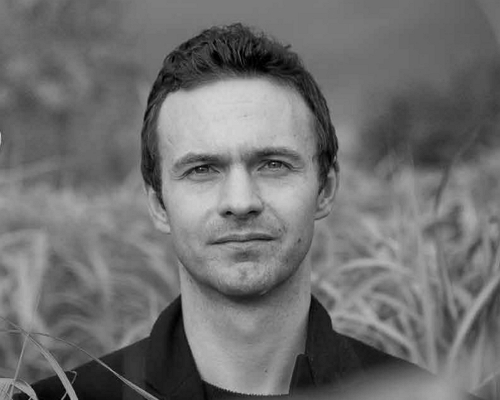
Dan Hayes
Celignis CEO And Founder
PhD (Analytical Chemistry)
<p style="text-align: left;">Dreamer and achiever. Took Celignis from a concept in a research project to being the bioeconomy's premier provider of analytical and bioprocessing expertise.</p>

Sajna KV
Bioanalysis Head
PhD
<p style="text-align: left;">Our Biomass Detective! Designs, tests, optimizes and validates robust analytical methods for our bioprocess development projects. Such bespoke analysis is key to developing an optimised bioprocess.</p>
Global Recognition as Bioprocess Experts
Extraction
Hydrolysis
Enzymes
Fermentation
Downstream Processing
Lab-Scale Optimisations
TRL Scale-Up
Technoeconomic Analyses
Biobased Chemicals
From Process Refinements to an Entire New Process
Research Collaborations
Hydrothermal carbonization (HTC) research has mainly focused on primary char production, with limited attention to secondary char, which is formed through polymerization and condensation of dissolved organic compounds in the liquid phase. This research aims to address this gap via an experimental investigation of the impact of stirring on the mass and carbon balance of HTC reaction products, surface functional groups, and surface morphology of secondary char, using fructose as a model compound. A 3D hydrodynamic simulation model was developed for a two-liter HTC stirred reactor. The experimental results indicated that stirring did not significantly influence the pH, mass, carbon balance, and surface functional groups of secondary char produced under the range of experimental conditions (180 C, 10% biomass to water (B/W) ratio, and a residence time of 0-120 min) studied. Nonetheless, it was observed that a stirring rate of 200 rpm influenced the morphology and shape of the secondary char microspheres, leading to a significant increase in their size i.e., from 1-2 um in unstirred conditions compared with 70 um at a stirring rate of 200 rpm. This increase in size was attributed to the aggregation of microspheres into irregular aggregates at stirring rates > 65 rpm and residence times > 1 h. The hydrodynamic model revealed that high turbulence of Re > 104 and velocities > 0.17 m s-1 correlated with regions of secondary char formation, emphasizing their role in particle aggregation. Particle aggregation is significant above a stirring rate of 65 rpm, which corresponds to the onset of turbulent flow in the reactor. Finally, a mechanism is proposed, based on reactor hydrodynamics under stirred conditions, that explains secondary char deposition on the reactor walls and stirrer. | |
A dried dairy processing sludge (sludge from wastewater treatment of an effluent from a milk processing plant) was pyrolysed in a single-particle reactor at different temperatures from 400 C to 900 C. NH3 and HCN were measured online and offline by means of FTIR as well as by cumulative sampling in impinger bottles (in 0.05 M H2SO4 and 1 M NaOH, respectively) and analysed by photometric method. NO and NO2 were measured online using a nitric oxide analyser while N2O was measured by FTIR. Nitrogen (N) in the sludge and in the remaining char, char-N, was determined. Moreover, tar content in pyrolysis gas was measured and tar-N was determined. The results with respect to N mass balance closure are discussed. The different measurements techniques are compared. For pyrolysis at 520 and 700 nitrogen in the gas phase was mainly contained as N2 (36 % and 40 % respectively), followed by NH3 (15 % and 18 %), tar-N (10 % and 9 %), HCN (1 % and 3 %), NO (1 %) and NO2 (0.2 %). The dairy processing sludge has very specific properties with organic-N present predominantly as proteins and a high content of inherent Ca. These characteristics affected the distribution of N. The amount of char-N was higher while the amount of tar-N lower than for sewage sludge from literature, at comparable pyrolysis temperature. | |
Dairy processing sludge (DPS) is a byproduct generated in wastewater treatment plants located in dairy (milk) processing companies (waste activated sludge). DPS presents challenges in terms of its management (as biosolids) due to its high moisture content, prolonged storage required, uncontrolled nutrient loss and accumulation of certain substances in soil in the proximity of dairy companies. This study investigates the potential of hydrothermal carbonization (HTC) for recovery of nutrients in the form of solid hydrochar (biochar) produced from DPS originating from four different dairy processing companies. The HTC tests were carried out at 160 C, 180 C, 200 C and 220 C, and a residence time of 1h. The elemental properties of hydrochars (biochars), the content of primary and secondary nutrients, as well as contaminants were examined. The transformation of phosphorus in DPS during HTC was investigated. The fraction of plant available phosphorus was determined. The properties of hydrochar (biochar) were compared against the European Union Fertilizing Products Regulation. The findings of this study demonstrate that the content of nutrient in hydrochars (biochars) meet the requirements for organo-mineral fertilizer with nitrogen and phosphorus as the declared nutrients (13.9-26.7%). Further research on plant growth and field tests are needed to fully assess the agronomic potential of HTC hydrochar (biochar). | |
Disposal of waste-activated sludge [dairy processing sludge, (DPS)] from wastewater treatment plants located in milk processing companies is an increasing concern. DPS is usually applied to farmlands in the vicinity of the dairy companies. This practice is becoming unsustainable due to uncontrolled nutrient loss and potential soil contamination. We propose to recover nutrients in the form of biochar. This paper examines the properties of biochars obtained from slow pyrolysis of DPS. DPS samples were pyrolyzed at laboratory and pilot scale at 600 and 700 C. The elemental properties of biochars, the content of primary and secondary nutrients, as well as contaminants were examined and compared against the European Union Fertilizing Products Regulation. The biochars meet the specified limits for hydrogen-to-organic carbon ratio, chloride, and polycyclic aromatic hydrocarbons intended for gasification and pyrolysis component category materials. In six out of eight biochars, the content of phosphorus (P) as a single declared nutrient and the level of contaminants meet those required for an organo-mineral fertilizer. Only two biochars meet the required concentrations of nitrogen, phosphorus, and potassium. A minimum solid content of 30% in DPS is required to make the process of biochar production energetically sustainable. | |
Anaerobically digested sewage sludge mixed with forest residues was pyrolysed at 800 C, at laboratory and pilot scale. The study quantified differences in char and gas yields for tests carried out in a simple fixed bed laboratory reactor and rotating retort pyrolyser at pilot scale, when the residence time of feedstock was 10 min in both cases. The yield of char from pilot scale was 4 % lower than from laboratory scale while the yield of gas was 15.7 % higher. During the pilot scale pyrolysis of anaerobically digested sewage sludge blended with forest residues the gas quality for energy recovery applications was assessed and the fate of impurities (tar, NH3 and H2S) was investigated. The raw pyrolysis gas contained 14.6 g/Nm3 of tar, 36.9 g/Nm3 of NH3 and 793 ppm of H2S. Sixteen N-containing tar species were identified of which pyridine, propenenitrile, 2-methyl-, benzonitrile, and indole are found to be the most abundant. The yield of N-containing tar compounds accounted for approx. 12 % of total tar content. Conditioned pyrolysis gas contained 7.1 g/Nm3 of tar, 0.036 g/Nm3 of NH3 and 119 ppm of H2S. Benzene was by far the most abundant tar compound followed by toluene and styrene. The specifications of the used internal combustion engine were exceeded due to the sum of tar compounds such as fluorantrene and pyrene with 4+ aromatic rings (at 0.0015 g/Nm3) and NH3 content The effectiveness and sustainability of energy recovery in wastewater treatment can be improved using forest industry by-products. | |
Adsorption of six contaminants of emerging concern (CECs) - caffeine, chloramphenicol, carbamazepine, bisphenol A, diclofenac, and triclosan - from a multicomponent solution was studied using activated biochars obtained from three lignocellulosic feedstocks: wheat straw, softwood, and peach stones. Structural parameters related to the porosity and ash content of activated biochar and the hydrophobic properties of the CECs were found to influence the adsorption efficiency. For straw and softwood biochar, activation resulted in a more developed mesoporosity, whereas activation of peach stone biochar increased only the microporosity. The most hydrophilic CECs studied, caffeine and chloramphenicol, displayed the highest adsorption (22.8 and 11.3 mg g-1) onto activated wheat straw biochar which had the highest ash content of the studied adsorbents (20 wt%). Adsorption of bisphenol A and triclosan, both relatively hydrophobic substances, was highest (31.6 and 30.2 mg g-1) onto activated biochar from softwood, which displayed a well-developed mesoporosity and low ash content. | |
Magnetic carbons can significantly lower the costs of wastewater treatment due to easy separation of the adsorbent. However, current production techniques often involve the use of chlorinated or sulfonated Fe precursors with an inherent potential for secondary pollution. In this study, ochre, an iron-rich waste stream was investigated as a sustainable Fe source to produce magnetic activated biochar from two agricultural feedstocks, softwood and wheat straw. Fe doping resulted in significant shifts in pyrolysis yield distribution with increased gas yields (+50%) and gas energy content (+40%) lowering the energy costs for production. Physical activation transformed ochre to magnetite/maghemite resulting in activated magnetic biochars and led to a 4-fold increase in the adsorption capacities for two common micropollutants - caffeine and fluconazole. The results show that Fe doping not only benefits the adsorbent properties but also the production process, leading the way to sustainable carbon adsorbents. | |
The majority of the sludge from the treatment of wastewater in milk processing plants is land spread. The drawbacks of land spreading include local oversupply due to high transport costs, which results in sludge being spread on lands in the vicinity of the dairy factories. Local oversupply can lead to accumulation of certain substances in soil through annual application over many years. Therefore, in the long term, there is a need for alternative methods to recover energy and nutrients from increasing volumes of sludge generated from dairy processing. Pyrolysis offers a potential alternative to land spreading, which can reduce health and environmental risks, while providing an avenue for the recovery of energy and nutrients. Pyrolysis allows energy recovery in the form of a high calorific value pyrolysis gas and a char which may be used as a soil amendment. In this study pyrolysis of dried dairy sludge was carried out at pilot scale. The results indicate that a dried biological sludge can be successfully pyrolysed and when mixed with wood the resulting char meets European Biochar Certificate criteria regarding carbon content. Most of the initial energy content of the feedstock was retained in the pyrolysis gas prior to cleaning, 53%, compared to 34.5% in the char and 1.5% in the tar. For the pyrolysis gas after cleaning (mainly cracking in presence of air) the initial energy content of the feedstock retained in the gas was only slightly higher than that retained in the char, 39.2% versus 34.5%, while the tar accounted for 0.8% of the initial energy content. | |
Eucalypts can be very productive when intensively grown as short rotation woody crops (SRWC) for bioproducts. In Florida, USA, a fertilized, herbicided, and irrigated cultivar planted at 2471 trees/ha could produce over 58 green mt/ha/year in 3.7 years, and at 2071 trees/ha, its net present value (NPV) exceeded $750/ha at a 6% discount rate and stumpage price of $11.02/green mt. The same cultivar grown less intensively at three planting densities had the highest stand basal area at the highest density through 41 months, although individual tree diameter at breast height (DBH) was the smallest. In combination with an organic fertilizer, biochar improved soil properties, tree leaf nutrients, and tree growth within 11 months of application. Biochar produced from Eucalyptus and other species is a useful soil amendment that, especially in combination with an organic fertilizer, could improve soil physical and chemical properties and increase nutrient availability to enhance Eucalyptus tree nutrition and growth on soils. Eucalypts produce numerous naturally occurring bioproducts and are suitable feedstocks for many other biochemically or thermochemically derived bioproducts that could enhance the value of SRWCs. | |

